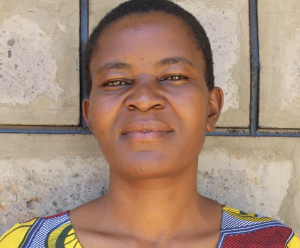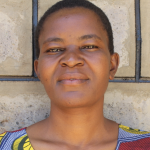"My first impression of this water point is that the source is open and contaminated. I would not drink this water," said Field Officer Rose Serete reflecting upon her first visit to evaluate Wanyama Spring.
Wanyama Spring serves 210 people in Indulusia, but their water needs are not fully met due to the spring's contaminated water.
"The water is not clean, and the source is open. We fear [drinking] because children throw dirty containers [into the water]; we are so worried about our health," said 60-year-old Christine Musavi, a farmer in the community.
Because the spring is open, animals often walk right through it and drink from it, leaving their waste in the area as well. Farm chemicals, dirt, and waste end up in the spring due to runoff from the rains. All of these contaminants mean that people spend a lot of time dealing with waterborne diseases. Community members report that diarrhea is one of their top water-related illnesses among families who depend on Wanyama Spring. Time spent at home sick means less time at work and school, and families drain their resources seeking medical attention. The money would have otherwise been better spent on their businesses, farms, and children's school fees.
The spring's poor access is another major issue. Right now, the area around the spring is bushy. Dangerous animals can easily hide in the bushes, making the spring unsafe for unchaperoned children, especially early in the morning or late in the evening. To reach the spring, community members must be careful not to slip on the mud and rocks slick with algae.
"I personally fear going to the spring alone because the area around the spring is so bushy, and bad animals like snakes can harm us," said primary school student Elias.
To aid in fetching water, community members tried to improvise a discharge pipe by lodging a plastic container between rocks, forcing some of the water to flow through the makeshift spout. But the frequent rains often wash away the container, causing people to waste more time while they go back home to look for a replacement jug. The container we saw being used at our last visit was very dirty, full of algae and dirt. This is highly concerning the quality of water passing through the container.
Like any other community, people use water in almost everything they do: in their daily chores, washing clothes, bathing, cleaning dishes, and even irrigation during the dry season. The difficult access and the long time it takes to fetch water at the spring means frequent delays for people - predominantly women - getting back to their work. As a result, certain activities have to be compromised if women are to have any time left to go to work, prepare meals, do some farming, and care for their families.
For example, some people bathe just once a week instead of daily, do dishes just once a day, and rarely do laundry due to the extra time it would take to fetch enough water to accomplish higher personal hygiene standards and care. Of course, people want to maintain the highest health and hygiene standards for themselves and their families, but as long as the spring is difficult to access, they cannot reach their goals.
What We Can Do:
Spring Protection
Protecting the spring will help provide access to cleaner and safer water and reduce the time people have to spend to fetch it. Construction will keep surface runoff and other contaminants out of the water. With the community’s high involvement in the process, there should be a good sense of responsibility and ownership for the new clean water source.
Fetching water is a task predominantly carried out by women and young girls. Therefore, protecting the spring and offering training and support will help empower the female members of the community by freeing up more of their time and energy to engage and invest in income-generating activities and their education.
Training on Health, Hygiene, COVID-19, and More
To hold training during the pandemic, we work closely with both community leaders and the local government to approve small groups to attend training. We ask community leaders to invite a select yet representative group of people to attend training, which will then act as ambassadors to the rest of the community to share what they learn. We also communicate our expectations of physical distancing and wearing masks for all who choose to attend.
The training will focus on improved hygiene, health, and sanitation habits in this community. We will also have a dedicated session on COVID-19 symptoms, transmission routes, and prevention best practices.
With the community’s input, we will identify key leverage points to alter their practices at the personal, household, and community levels to affect change. This training will help ensure participants have the knowledge they need about healthy practices and their importance to make the most of their water points as soon as the water is flowing.
Our team of facilitators will use a variety of methods to train community members. These methods include participatory hygiene and sanitation transformation, asset-based community development, group discussions, handouts, and demonstrations in the spring.
One of the most important issues we plan to cover is handling, storing, and treating water. Having a clean water source will be extremely helpful, but it is useless if water gets contaminated by the time it is consumed. The community and we strongly believe that all of these components will work together to improve living standards here, which will help to unlock the potential for these community members to live better, healthier lives.
We will then conduct a small series of follow-up training before transitioning to our regularly scheduled support visits throughout the year.
Training will result in the formation of a water user committee, elected by their peers, that will oversee the spring's operations and maintenance. The committee will enforce proper behavior around the spring and delegate tasks that will help preserve the site, such as building a fence and digging proper drainage channels. The fence will keep out destructive animals and unwanted waste, and the drainage will keep the area’s mosquito population at a minimum.

 Protected Spring
Protected Spring
 Rehabilitation Project
Rehabilitation Project








































